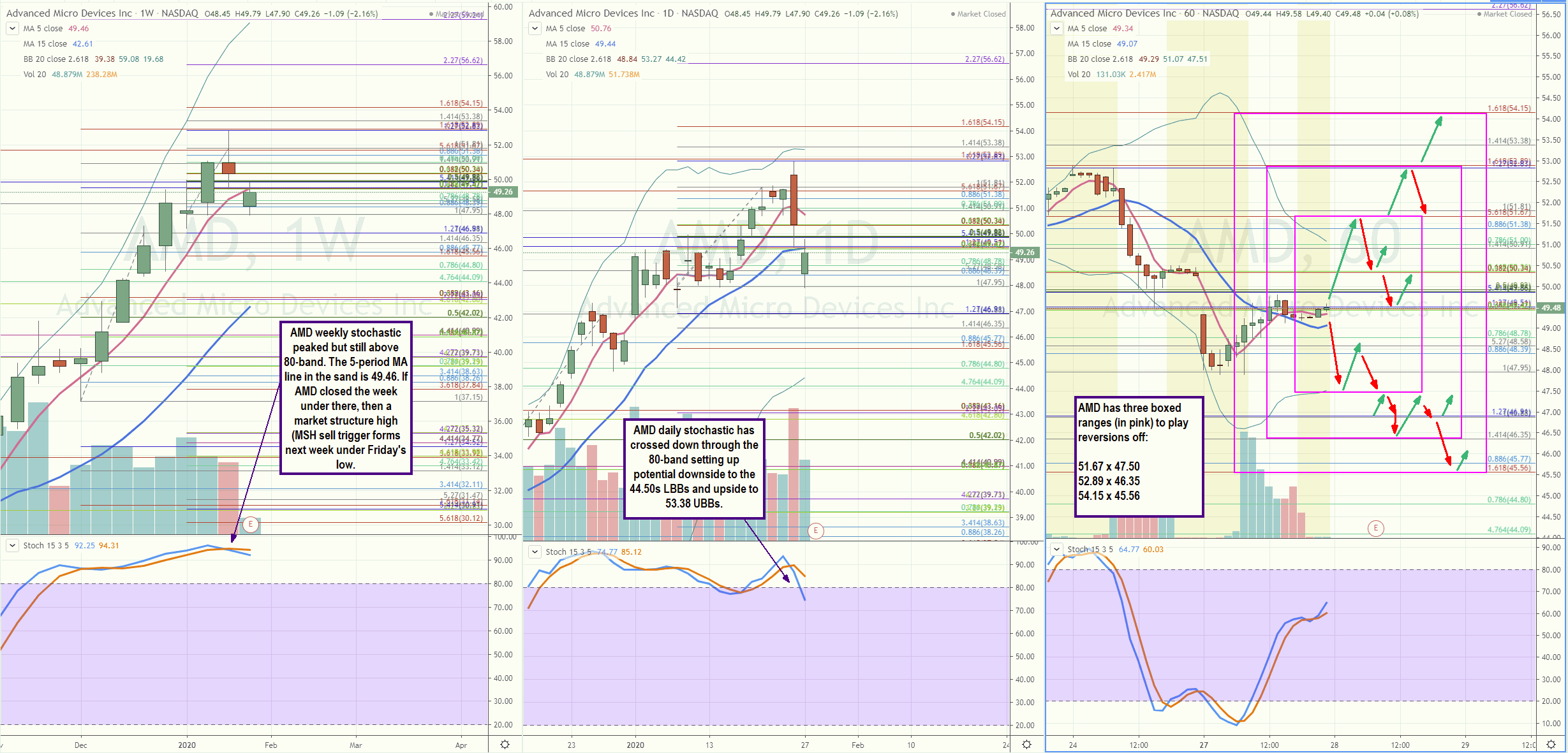Semiconductor manufacturer Applied Micro Devices
NYSE: AMD reports Q4 2019 earnings after the close on Tuesday, Jan.28, 2020. Consensus analyst expectations are $0.30-earnings per share (EPS) on $21.052 billion in revenues. This manufacturer of central processing units (CPU), graphic processing units (GPU) have bolstered market share from competitors Intel
NASDAQ: INTC and NVidia
NASDAQ: NVDA. While companies like Micro Technologies and Intel have stated that the semiconductor market has bottomed, the question is whether these stocks have gotten too far ahead of themselves and due for a pullback.
Macro Context and Influences
The S&P 500 ETF NYSEARCA: SPY is our macro market indicator. The SPY sold-off on a double whammy of the Corona virus and falling yields taking the steam out of the financials. Buyers were able to defend the breakeven price level at 323.50 line in the sand to keep the SPY positive on the year. The Federal Open Market Committee (FOMC) rate decision and Q&A session after 2pm EST on Wednesday, Jan. 28, 2020, will be the macro market catalyst. This may accelerate the direction of the gap in the last hour for AMD shares on Wednesday.

Technical Analysis
AMD shares have exploded in the past year rising from $19.05 to hitting an all-time high at $52.81 last Friday on Intel earnings before selling off to the $47.95 fib. Utilizing the rifle charts, the weekly stochastic has peaked and crossed down but remains above the 80-band. This places the 5-period moving average (MA) resistance at 49.46. The daily stochastic has formed a crossover down through the 80-band triggering a sell-off clear through the 5-period MA at 50.76 and 15-period MA at 49.44. If AMD closes under the weekly 5-pd MA at 49.46 on Friday’s close, then a market structure high (MSH) sell trigger forms next week under Friday’s intraday low price. The daily upper Bollinger Bands (UBBs) target 53.38 fib and lower Bollinger Bands (LBBs) target 44.50s. A breakout through the 52.89 dual 0.618 fibs can short-squeeze shares towards the next 0.618 fib at 54.15. A breakdown below the 46.93 fib can drive shares to the 45.56 area which is a 0.618 fib and the 44.50s LBBs.
Sympathy Stocks:
AMD tends to correlate best with semiconductors in the storage/memory and graphic chips space. These include leading graphics chip maker NVIDA NASDAQ: NVDA, storage/memory chip makers Micron Technologies NYSE: MU, Western Digital NYSE: WDC and Seagate Technologies NYSE: STX. NVDA tends to lead AMD, but the roles can reverse (dog wags the tail) after AMD earnings release. Pay close attention if they start to diverge directions intraday.
Trading Game Plan: Post-Market
AMD is a very liquid trading stock that’s ideal for scaling into positions. It’s a good idea to still watch NVDA as a lead stock. Secondary stocks MU and WDC also provide laggard opportunities during the day. There are three basic envelope ranges: 51.67 x 47.50, 52.89 x 46.35 and 54.15 x 45.56.
Very experienced traders may consider using these envelopes as reversion levels in the post-market earnings action. The basic rule of thumb is to scalp reversions quickly and not get trapped in a grind. If AMD gaps down hard, then watch for a 5-min MSL trigger off a lower fib for a coil into the 5:00 pm EST conference call. Don’t try to understand the reason behind the price moves, just focus on the reactions off the price inflection levels. Chip stocks are all about sentiment.
Trading Game Plan: Next Day Market Open
With the complete layout of the playing field, make sure you understand the three-reactions off the open on gappers. You can play the initial reversions off a fib in the first 20-minutes but make sure to shift to the 5-minute and 15-minute rifle charts for the third reaction trend move to materialize near 10:00 am EST. Pay attention if NVDA starts to move inversely with AMD and watch for laggard opportunities trading MU and then WDC. If AMD is a dumper, then watch for NVDA to make a market structure low (MSL) bottom to scalp coils on AMD, MU, and WDC. If AMD continues to sell-off despite the rest of the peers bouncing, then negative correlation has taken over and consider fading the peers on an MSH trigger. The average scalp can range from $0.05 to $0.40 with thick liquidity in the beginning of the day but gets tighter with time. Don’t hesitate to take stops after three or more scale-ins and make sure to spread out the entries wider to tighter as the day wears on.
Before you make your next trade, you'll want to hear this.
MarketBeat keeps track of Wall Street's top-rated and best performing research analysts and the stocks they recommend to their clients on a daily basis.
Our team has identified the five stocks that top analysts are quietly whispering to their clients to buy now before the broader market catches on... and none of the big name stocks were on the list.
They believe these five stocks are the five best companies for investors to buy now...
See The Five Stocks Here
Which stocks are likely to thrive in today's challenging market? Enter your email address and we'll send you MarketBeat's list of ten stocks that will drive in any economic environment.
Get This Free Report
Like this article? Share it with a colleague.
Link copied to clipboard.